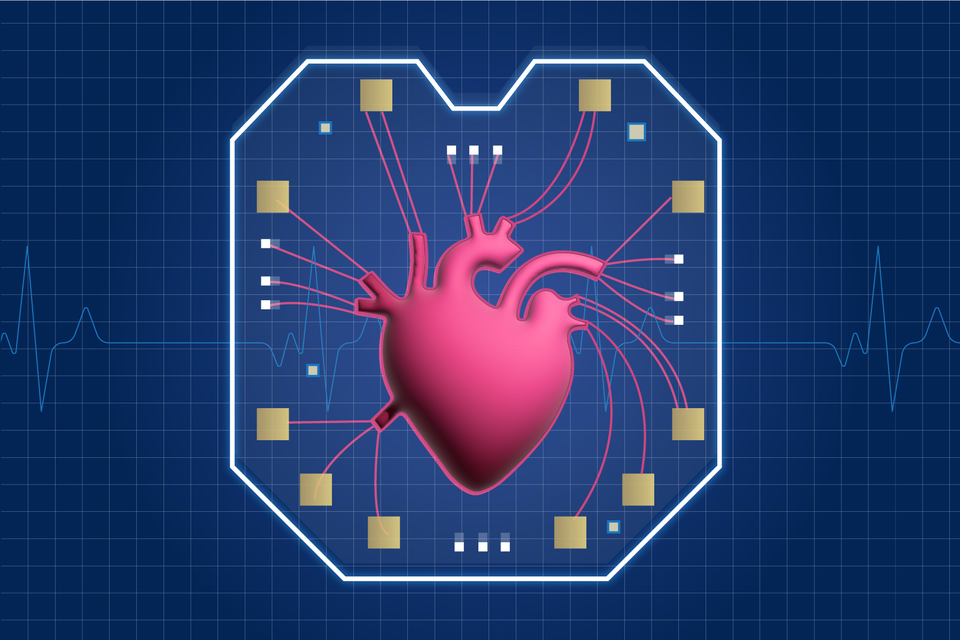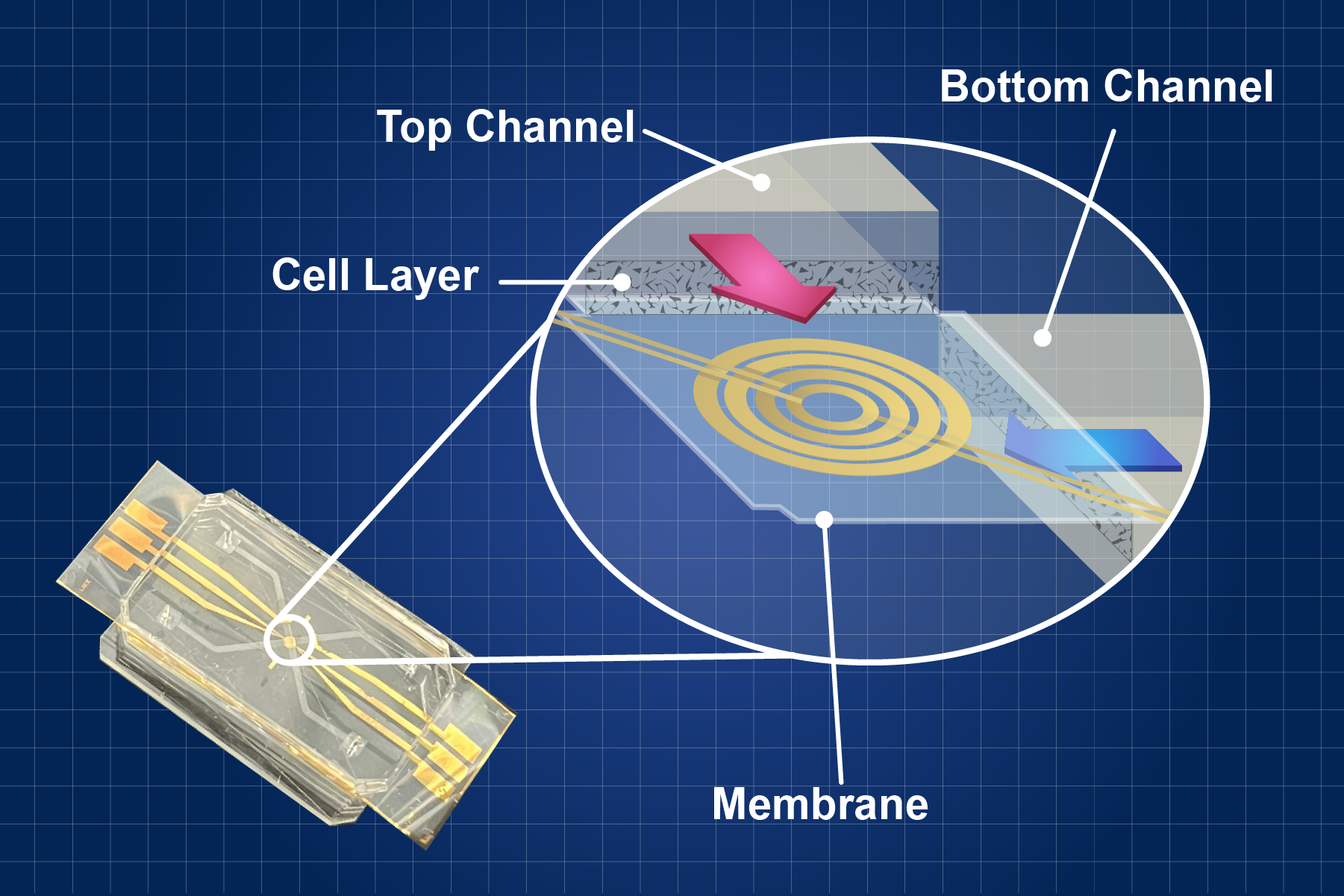- NIST is developing a “heart-on-a-chip” system that captures aspects of human heart function for studying cardiovascular disease.
- NIST has surveyed the state of the technology, which includes efforts across the scientific community, in a review article.
- An organ-on-a-chip suite, which would include heart-on-a-chip, could ensure safer, faster and more precise drug development and reduce the need for animal testing.

Editor’s Note (May 2, 2024): This news article has been updated to clarify that the heart-on-a-chip system at NIST is still in development and that the Lab on a Chip article referenced is a review of work on this technology across the scientific community.
Researchers at the National Institute of Standards and Technology (NIST) have developed bioelectronic devices capable of real-time measurements of cell behavior. Researchers are integrating these components into their version of a system known as heart-on-a-chip (HoC). This technology seeks to address the limitations of conventional cardiovascular drug development, which relies heavily on animal testing. By capturing key aspects of the human cardiovascular system in a laboratory setup, the HoC holds the possibility of helping to replace animal testing with a more accurate representation of the human body, thus shortening drug development timelines and reducing costs.
NIST researchers recently surveyed the state of the technology, which includes efforts across the science community, in a review article in the journal Lab on a Chip. NIST’s work on HoC is part of a larger organ-on-a-chip suite being developed at the agency, including a “body cube,” which mimics the human body’s organ functions in a 3D arrangement.
The HoC is a device that captures the intricate interactions of cells within the heart on a small chip. The actual design of the heart-on-a-chip varies, but it is typically a small, transparent or semi-transparent chip consisting of a network of microchannels printed on a layer of polymer. These microchannels are intricately designed to imitate the blood vessels found in the human heart. Researchers place human heart cells within these microchannels to manipulate and observe their behavior. Researchers can independently stimulate them or observe their behavior under different conditions, such as the introduction of a drug.

According to NIST researcher Darwin Reyes, who leads the development of this system, the heart-on-a-chip NIST is designing aims to mimic the conditions of a real heart. The goal is to manipulate the environment to change stem cells into heart cells and make them contract and relax, as they do in a body to produce a heartbeat.
The “heart” of the organ-on-a-chip system lies in something called microfluidics, which is essentially a miniature plumbing system in which researchers can precisely control and manipulate tiny amounts of liquids. Researchers use microfluidics to create advanced models of organs and tissues on small chips in the lab.
According to Reyes, the bioelectronic device could be used with many different cell types. For the HoC project, the researchers are using heart cells, but a customized version of the system has been used with other cells to monitor their behavior visually and electronically.
Researchers can create chips that mimic the conditions of various organs in addition to the heart, and these chips can even be interconnected to form a multi-organ system. For example, you could have a heart-on-a-chip connected to a liver-on-a-chip to simulate how the heart and liver interact in response to certain drugs or medical conditions. This approach provides a more comprehensive understanding of how different organs function together in the human body. NIST works to understand sources of uncertainty in these devices and develop the design and fabrication techniques to realistically represent human physiology on the microscale.
Rethinking Animal Testing
In traditional drug development, animals are often used as test subjects. However, animal physiology does not perfectly match human physiology. A drug may pass a test on an animal subject but may then fail in human testing. This not only delays the drug testing process but also puts human test subjects at risk of adverse effects from the drug. Additionally, there is ongoing debate about the ethical considerations of animal testing.
“The ultimate goal is to, if possible, be able to skip the animal testing altogether,” said Reyes. “This would also shorten the time it takes to test drugs, which would hopefully make the medications cost less.”
In 2022, President Joe Biden signed into law the FDA Modernization Act 2.0. The bill essentially revises the Federal Food, Drug, and Cosmetics Act of 1938, which mandated animal testing for every new drug development protocol. While for the past century, the mandate was intended to ensure certain quality and safety standards for drugs and medical devices, recent advancements in science have begun to offer increasingly viable alternatives to animal testing, including organ-on-a-chip systems.
Global Collaboration for Standardizing Organ-on-a-Chip Technology
Developing this new technology is not done in a vacuum. Researchers across the world are working on similar microfluidic devices to usher in a new era of drug development. However, to make this a reality, there's a need for standardization — establishing consistent guidelines and rules for these technologies. This not only helps in gaining regulatory approvals but also ensures better acceptance in the scientific, industrial and medical communities. NIST is an active participant, along with scientific organizations across the globe, in developing standards for this technology.
“The more collaborative research there is outside of what is currently being done and where we're heading, the better this technology is going to be,” said Reyes.
Expanding Horizons Beyond Cardiovascular Focus
While HoC is focused on cardiovascular drug development, the OoC capabilities extend beyond a specific organ. The system can be applied to various cell types, including those relevant to cancer research.
“We are in the test phase of understanding how we can track the movement and aggressiveness of cancer cells in real time,” shared Reyes. “Our hope is, in the future, with more testing, the system may be able to provide measurements of cancer cell aggressiveness that could help with diagnosis.”
Developing this new technology, underpinned by rigorous standards, marks an important step toward a future where drug development is characterized by precision, efficiency and heightened ethical considerations.
Paper: Derrick Butler and Darwin R. Reyes. Heart-on-a-Chip System: Disease Modeling and Drug Screening Applications. Lab on a Chip. Published online Feb. 6, 2024. DOI: 10.1039/D3LC00829K

